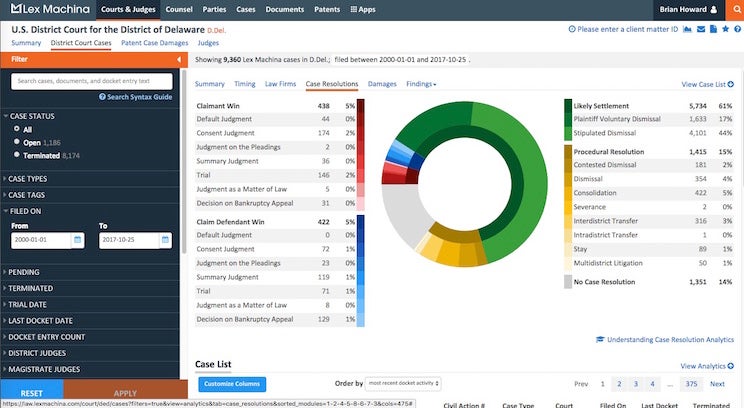
There are few in-house counsel who can remember when their remit did not require them to become more efficient year over year, especially with their patent department’s budget. Simply overseeing an effective legal strategy for managing the organization’s intellectual property (IP) assets is not enough. A significant percentage of in-house IP lawyers now track quality as a key performance indicator of how their in-house patent processes are functioning.
As we are coming to understand, big data is essential in moving legal departments forward. It can arm in-house lawyers and their outside counsel with strategic insights that enable them to craft effective IP litigation and portfolio management strategies. Patent analytics can help in-house law departments achieve material gains for better patent quality while reducing overall costs.
Patent analytics and IP management
Patent analytics enable in-house law departments to see trends on a scale and depth that were not possible to visualize in the past. IP portfolio management is a major beneficiary of these new technology tools as analytics allow decision-makers to optimize their approach to patent drafting, prosecution, and protection.
There are a few key ways that in-house counsel can leverage analytics to improve their IP litigation and portfolio management:
Better Patent Drafting
Very few companies do their own patent drafting; however, many either insist or simply assume their outside counsel uses patent drafting tools to help reduce errors that cause §112 rejections. This may lead to unenforceable patents — all in an effort to save on time and reduce outside counsel fees. Some software solutions find language that is vague or that does not support specific structure, materials or claimed function, terms that lack a proper antecedent basis, or claims in improper form for single or multiple dependency. Avoiding these errors is a design for better patent quality.
Monitor prosecution progress
The majority of patent prosecution budgets are tied to a minority of applications. Unfortunately, many of these same applications are later abandoned. Software is now available that uses patent analytics to identify applications that may be at risk so in-house counsel can adjust strategy as appropriate to save time and money. One way to do this is to set custom alerts for selected patterns of events and isolate specific applications that need the most attention. Additionally, when patent analytics indicate a rather easy examination process, this information can be used to retain broader claims. While negotiating claims for an application, it is now possible for some programs to search PDF documents so that companies can review the claims and how others were able to overcome examiners’ objections.
A simple review of an examiner’s statistics cues you into how aggressive you will need to be in your amendments to your patent claims.

Portfolio metrics
Analytics help in-house legal teams to discover how the metrics of their patent portfolio compares with those of competitors as well as the ability to set up alerts on competitors’ public applications. Understanding areas of weakness can help departments hone in on specific areas for improvement. Companies can also use set up alerts that incorporate benchmark measures for what is typical for a specific examiner or art unit. Patent statistics can monitor and return applications exceeding those averages so strategy can be re-addressed on those applications.
Select and review success of outside counsel
Some patent analytics tools enable in-house counsel to compare the success rates of outside counsel within the most important art units for a specific company. Law firms may provide statistics that cover all art units they cover; however, this information can be misleading as allowance rates vary greatly across art units. Patent analytics can be used to compare the prosecution efficiency of lawyers or law firms. Numerous metrics can be reviewed, such as average time to allowance, average number of Requests for Continued Examination (RCEs) required, percentage of applications appealed, and abandoned applications. These statistics not only help in the selection of outside counsel, but also guide conversations for the strategic approach of specific applications that can yield material improvements.
Succeeding in litigation
Legal analytics offer tremendous insights to uncover trends that bolster litigation strategy as well. For in-house counsel, tools like Lex Machina™ can help companies select the best law firm to handle a matter by comparing case timing statistics, such as success in winning previous cases, damages won or lost, and injunctive relief. Outside counsel can similarly demonstrate their success quantitatively, for example showing a potential client how they surpass the client's current counsel in key metrics. Litigators can learn about a judge's behavior (e.g., prior experience with similar cases, timing and amenability of motions practice, and damages history), or even the behavior of a district as a whole, which can be invaluable for evaluating whether to seek transfer. Lex Machina and other similar services allow lawyers to explore the litigation history of the opposing counsel or parties along similar metrics. For example, one might react differently to a firm that has filed more than 50 cases, all of which have settled within months, than one might to a firm that has taken multiple cases to trial and won. Understanding the data behind the litigation landscape improves the ability of companies to select and budget counsel, and of firms to win cases.

Legal analytics in practice
In-house legal teams are increasingly leveraging patent analytics in practical ways to optimize their approach to patent prosecution and to better protect their patents. It is now possible to dissect allowed patent claims and analyze claim elements for both literal and conceptual matching. Patent lawyers can find elements within their claim set that lack or have vague antecedents and quickly find prior art and case law references to the key elements. Starting to protect patents in the drafting stage is obviously much more cost-effective than in the litigation stage.
The global software company Oracle is using patent analytics to achieve competitive advantages in patent portfolio development and prosecution. The Oracle team looks carefully at the USPTO examiner’s statistics as well as law firm statistics to help determine where resources can be most efficiently devoted to securing reasonably broad patent protection, both before applications have been filed and as strategies change for applications during prosecution.
To surface this valuable intelligence, Oracle relies on LexisNexis PatentAdvisor™, a data-driven patent strategy tool that provides a systematic approach to crafting an effective prosecution strategy and managing an IP portfolio. The tool allows in-house counsel to understand why certain patent applications take longer than others to reach allowance, then use that knowledge to devise better strategies, manage budget, and evaluate both in-house and outside IP counsel.
“By using patent analytics tools such as PatentAdvisor, we’ve been able to significantly decrease patent prosecution expenses for a large number of cases that could have otherwise been stuck for several additional years in prosecution with the patent examiner,” said Eric Sutton, senior patent counsel at Oracle. “For cases with predictably lower likelihoods of success according to a first pass claiming strategy, we tend to fast forward to the end of the movie because we already know the plot. Patent analytics is not the future, it is here now. It allows for more strategic patent prosecution at a lower cost and higher quality for our patents, in terms of breadth, value to us and our competitors, and likelihood of validity. Over time, that is a real competitive advantage.”
Conclusion
More strategic patent prosecution and drafting will allow companies to be more cost-effective and reduce their patent spend. In-house lawyers are realizing a competitive advantage as they can achieve both better outcomes and cost savings. During the patent drafting process, there are data analytics tools that can reduce the number of patent rejections a company will receive and help ensure a granted patent is less likely to be litigated. That means companies can obtain patents strategically with limited amendments, fewer errors, and at a lower cost.
Patent analytics provide opportunities for in-house counsel to improve their department’s efficiency with a strategic approach to patent drafting and prosecution. They allow executives to customize their approach to patent prosecution in real-time with actionable data and analytics, framed within the context of the patent office, to support a successful IP portfolio management strategy.
While this piece focuses on analytics in the IP space, big data and analytics in general are reshaping the entire fabric of the legal profession. In-house counsel must stay informed of the rapidly changing world of analytics, so that they can adapt to their industry’s needs.




